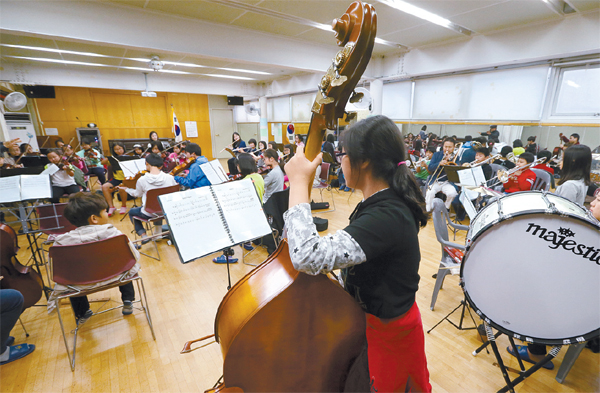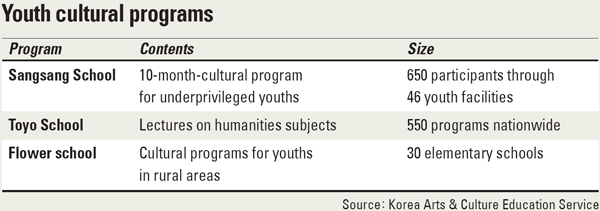Music enriches the lives of poor teenagers

Members of the Orchestra of Dreams practice playing classical music on Oct. 15. The teen orchestra program is modeled off El Sistema, Venezuela’s 38-year-old free music education program for minors who come from poor socioeconomic backgrounds. By Choi Seung-sik
As an only child, Ki-young came from a broken home and lived with his father.
The situation was dire. Ki-young’s father was abusive, and a district office in Seoul eventually ordered the teen to be removed from his home and taken into the care of a state-run community center.
Just when the teen thought things couldn’t get any worse, his situation took a fortuitous turn.
He decided to join the Orchestra of Dreams, an adolescent orchestra for underprivileged young people run by the district office.
Much to his surprise, Ki-young discovered he had a talent for music - more specifically, a talent for playing the viola.
Last Sunday, Ki-young stood on stage to perform with Venezuela’s Youth Orchestra of Caracas at Deoksu Palace in central Seoul.
After playing the songs that he had practiced for months, the sixth grader said it was as though one of his dreams had come true.
As public interest has grown in a cultural curriculum aimed at young people, an increasing number of government-sponsored arts programs for teenagers, especially underprivileged youths, have emerged.
The Orchestra of Dreams was founded in 2010 as part of the Ministry of Culture, Sports and Tourism’s campaign to expand access to cultural experiences for underprivileged children.

The team gives free lessons to children from lower income brackets or those raised by single parents. It also provides instruments to its members for free.
The movement to foster government-led cultural programs for underprivileged teenagers has also spilled into the private sector.
The Foundation for Preventing Youth Violence, a private group founded in 1995, previously focused its anti-school violence efforts on talks and lectures.
Recognizing the role art programs have in inspiring young people, the group decided to produce its first musical, “Ghost Friends,” with school violence as its theme.
Yet, as art programs have increased, individuals involved with those organizations say government funding is lacking. They also say that consistent and additional government support is crucial for maintaining and expanding current programs.
“The government will stop helping us next year,” said an official at Ki-young’s orchestra team, “so we are now looking for a private sponsor to keep the program.”
However, solely relying on government funds will not solve the problem, said Kim Se-hoon, professor of culture and tourism at Sookmyung Women’s University.
“Blaming the government for a lack of funds will not improve the quality and quantity of cultural programs,” Kim said.
“Creating a social environment that encourages more private sponsorship for such cultural programs will be a key to the long-term sustainability of such projects.”
BY SHIN JOON-BONG [jkkang2@joongang.co.kr]










with the Korea JoongAng Daily
To write comments, please log in to one of the accounts.
Standards Board Policy (0/250자)